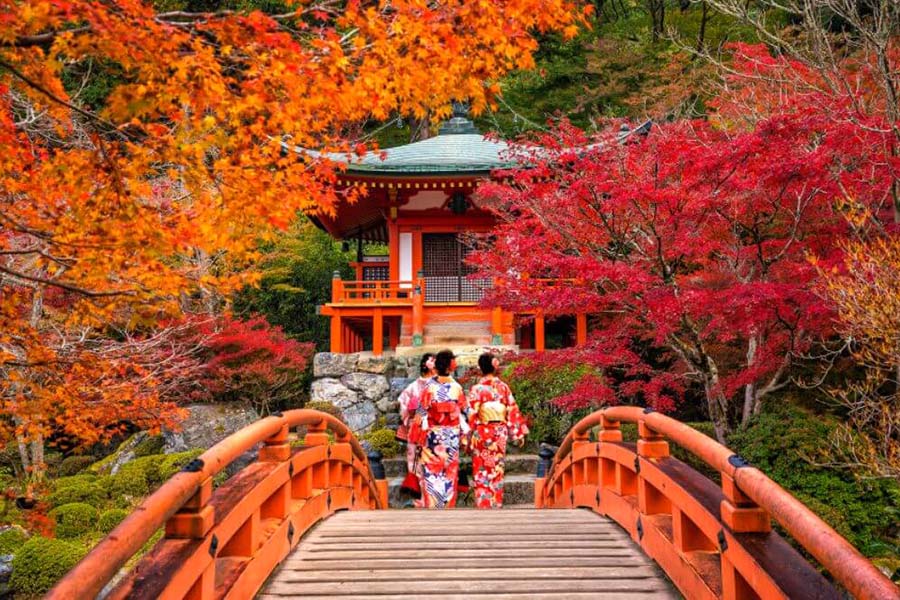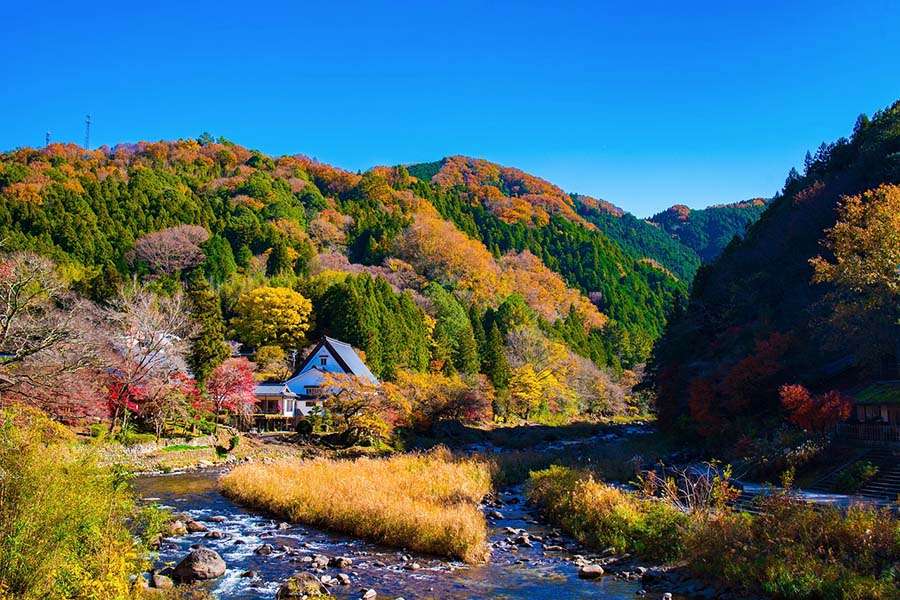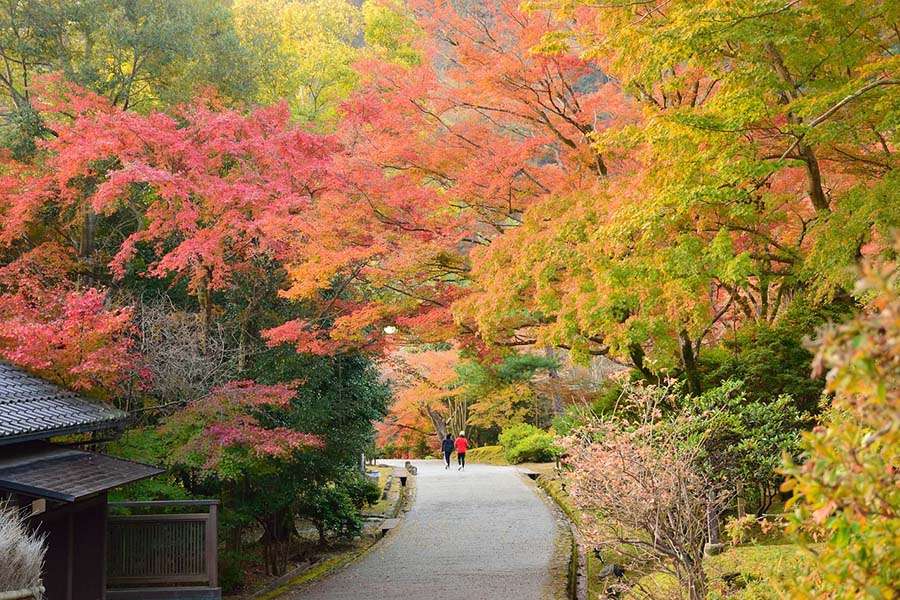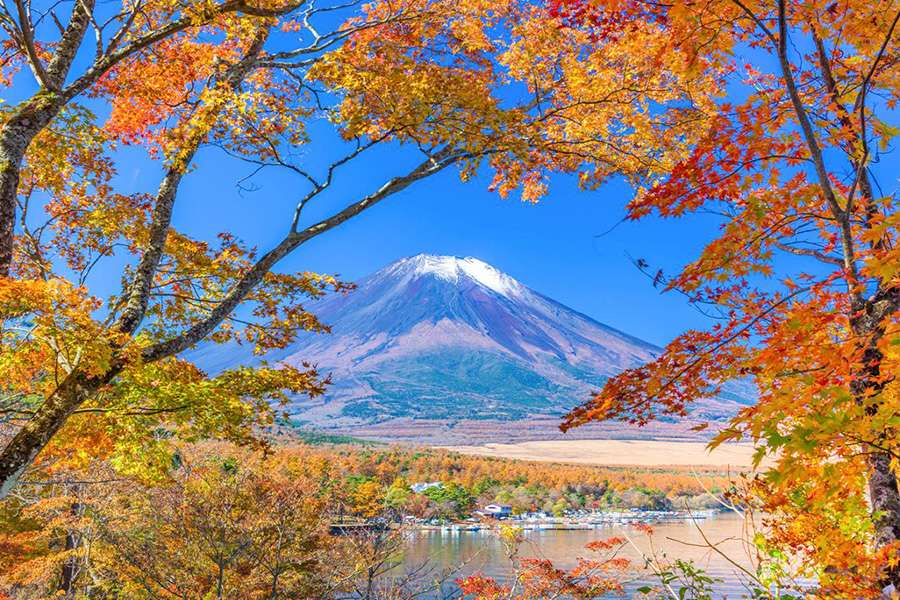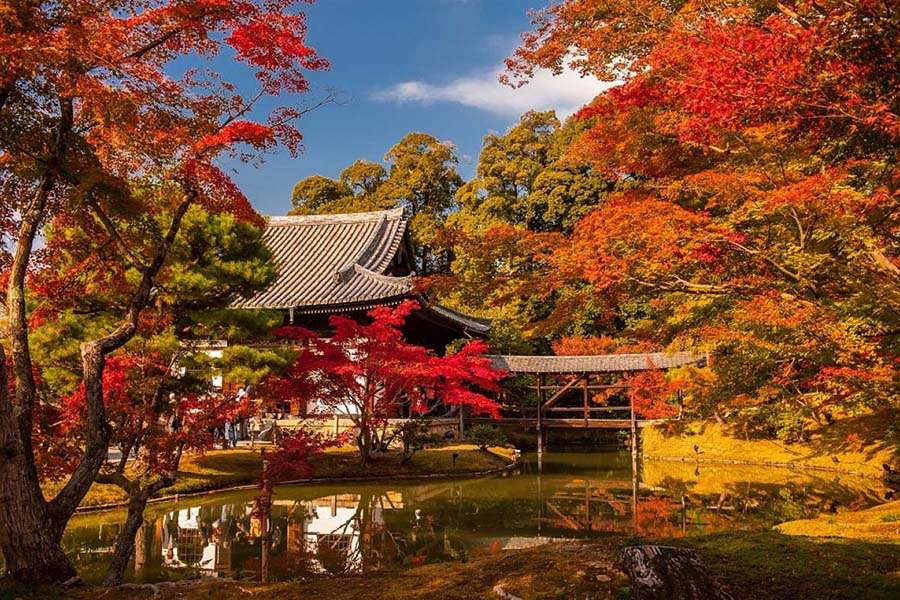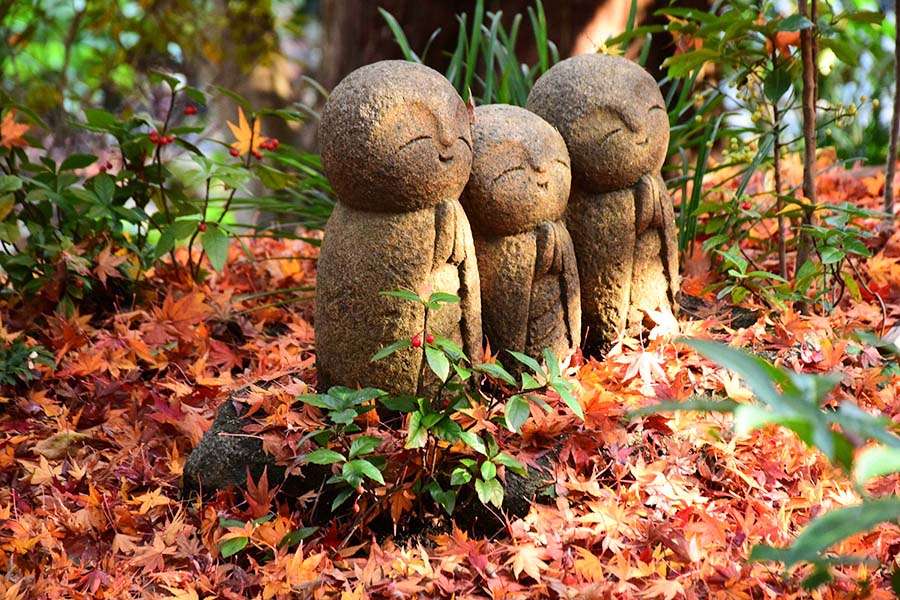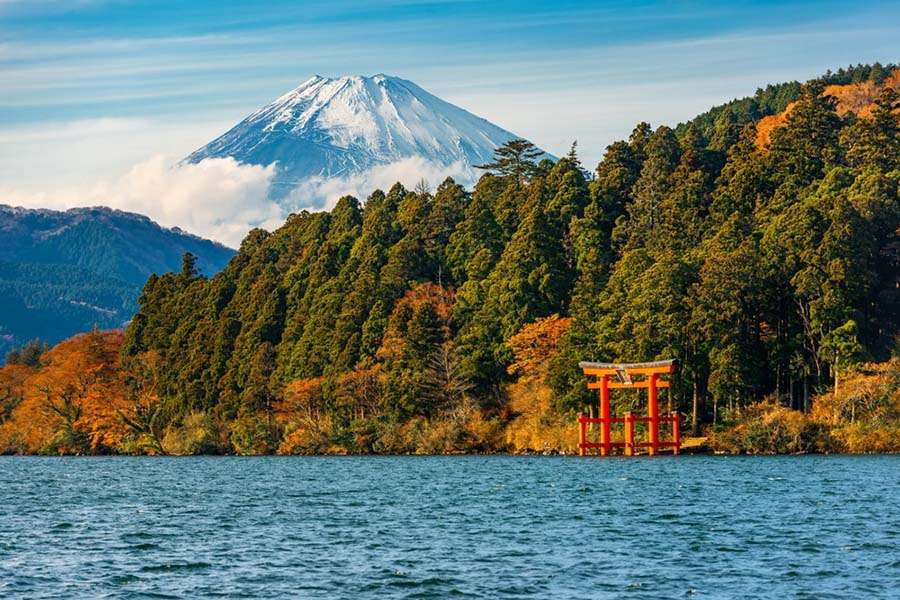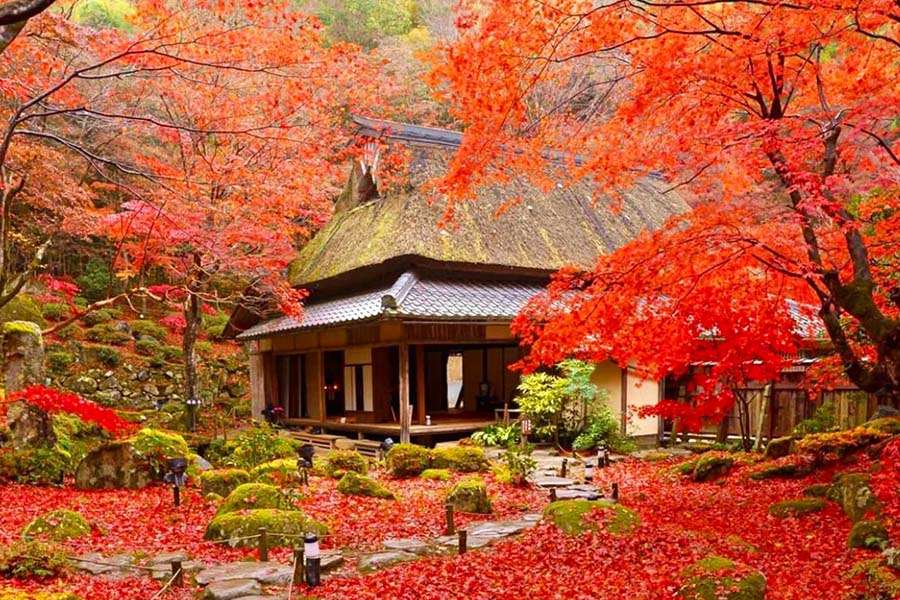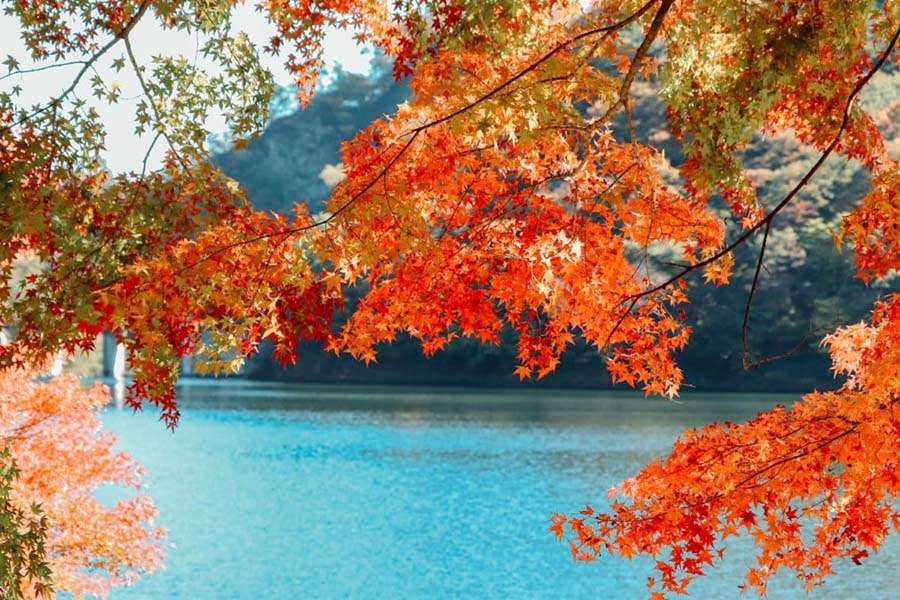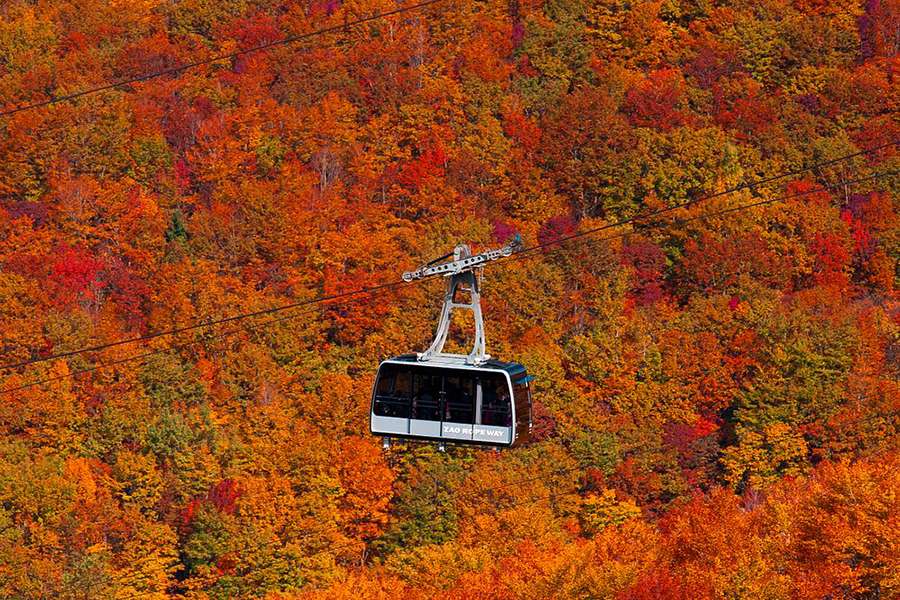Fall is a wonderful time to explore Japan. In many ways, the country’s autumn foliage surpasses the beauty of its spring cherry blossoms with a dazzling display of seasonal colors. The transformation of Japan's scenery into a vivid mosaic of hues is truly a must-see. But when does this vibrant season unfold, and where can you experience the best views of Japan’s autumn leaves? This guide offers everything you need to plan an unforgettable trip to Japan.
Autumn in Japan, known as Aki, highlights two main types of fall colors: Koyo and Momiji. Koyo refers to the overall autumn palette of red and yellow leaves, while Momiji specifically focuses on the strikingly red maple leaves that are especially captivating during this time. The maple leaf is a well-known symbol of autumn in Japanese culture, and the term Momijigari, meaning "hunting red leaves," captures the excitement of visitors eager to witness Japan's vibrant fall landscapes.
When is Fall Foliage in Japan?
Japan’s autumn season lasts from mid-September to early December. During this time, temperatures range from approximately 45°F (7°C) on cool late autumn evenings to 75°F (24°C) during warmer days in September. In Hokkaido, the first signs of fall colors appear from mid-September to early October, while the Tohoku region reaches its peak around mid-October. Tokyo and Kyoto usually offer the most scenic autumn views from mid-October to early December, with Kyushu showcasing its brightest colors toward late November.
Unlike the unpredictable cherry blossoms, autumn in Japan offers a more extended and predictable period for enjoying fall colors. This allows for easier planning around the vibrant autumn scenery. Here are the general timeframes to experience Japan’s autumn foliage.
| DESTINATION | YELLOW LEAVES | RED LEAVES |
|---|---|---|
| Daisetsuzan | September 15 | September 25 |
| Hachimantai | October 5 | October 15 |
| Mt. Hakkoda | October 15 | October 25 |
| Kurobe Gorge | October 25 | November 5 |
| Kakunodate | October 15 | October 25 |
| Nikko | October 25 | November 5 |
| Tokyo | November 25 | December 5 |
| Takayama | October 25 | November 5 |
| Fuji Five Lakes | October 25 | November 5 |
| Kanazawa | November 15 | November 25 |
| Kyoto | November 25 | November 25 |
| Setouchi | November 25 | November 25 |
| Shikoku | November 25 | December 5 |
| San'in | November 25 | November 25 |
| Kyushu | November 25 | December 5 |
Best Locations to See Autumn Leaves in Japan
Tokyo
Autumn in Tokyo is truly stunning. Known globally as a vibrant metropolis with abundant green spaces, Tokyo offers some exceptional spots to experience the fall colors. Highlights include:
- Jingu Gaien Ginkgo Avenue: A renowned street lined with ginkgo trees that turn a brilliant yellow in autumn.
- Koishikawa Korakuen: A well-loved garden near Tokyo Dome, featuring numerous maple trees.
- Mount Takao: Situated on the city's outskirts, this popular weekend destination is perfect for an autumn hike.
- Oze National Park: A favored hiking location about 100 kilometers north of Tokyo.
- Rikugien Garden: A stunning landscape garden renowned for its red leaves and cherry blossoms.
- Shinjuku Gyoen: A spacious city park ideal for autumn picnics.
- Ueno Park: A large green area with over 9,000 trees displaying impressive fall colors.
- Yoyogi Park: Near the trendy Harajuku area, offering a blend of ginkgo and maple trees with vibrant autumn hues.
Mt. Fuji
Mount Fuji is an iconic symbol of Japan and a popular destination for travelers. While winter is often regarded as the ideal time to see its snow-covered summit, autumn brings its own distinct beauty with vivid colors. From early October to late November, the surroundings of Mount Fuji and Lake Kawaguchiko are prime locations for enjoying fall foliage. The elevation of more than 800 meters at the base of Mount Fuji leads to notable temperature differences between day and night, which intensifies the vibrancy of the autumn leaves.
Some of the most enchanting spots include:
- Oishi Park: Renowned for its kochia plants that turn a striking red in autumn.
- Momiji Tunnel: Provides a picturesque view of Mount Fuji framed by maple trees.
- Kubota Itchiku Art Museum: Features beautiful silk kimono works by Kubota Itchiku and boasts a stunning garden with seasonal displays.
- Maple Corridor: A scenic, tree-lined path along the northern shore of Lake Kawaguchi.
- Mt. Fuji Panoramic Ropeway: Offers not only transportation but also spectacular views of Lake Kawaguchi, Mount Fuji, and the surrounding autumn landscape from the top of Mount Tenjo.
Kyoto to Kasuga Shinto Shrine
Kyoto, renowned as a fall foliage paradise in Japan, enchants visitors with its rich array of Buddhist temples, shrines, Japanese gardens, tea houses, mountains, ponds, and garden bridges. During autumn, the city offers breathtaking vistas of vibrant yellow leaves that create a romantic atmosphere.
Some of the top spots for autumn leaf viewing in Kyoto include:
- Kiyomizu-dera: One of Kyoto’s most iconic temples, known for its spectacular illuminated fall foliage and over 1200 years of history.
- Daigo-Ji Gardens: A spacious green area favored by photographers for its autumn scenery.
- Daitoku-Ji: Features an impressive maple tree tunnel at its entrance.
- Eikando Temple: Renowned for its beautifully lit trees during the fall season.
- Kinkaku-Ji: The gold-leafed temple perfectly contrasts with the colorful autumn leaves surrounding it.
- Todai-ji Temple: Offers a mesmerizing display of autumn foliage, along with views of deer and maple trees.
- Nanzen-Ji: Gained fame from the film Lost in Translation, which featured scenes of this temple in the fall.
- Tenryu-Ji: A UNESCO World Heritage Site known for its stunning landscape garden.
- Tofuku-ji Temple: Home to the Tsutenkyo Bridge, one of the city’s most popular spots for leaf viewing.
Hidden Gems for Enjoying Japan's Fall Foliage Without the Crowds
Japan's fall foliage season starts in mid-September and extends for almost three months, stretching from Hokkaido in the north to Kyushu in the south. Seeking out quieter locations can greatly enrich your experience. These hidden spots provide a more peaceful environment compared to the busy, well-known areas. Below are five of the best lesser-known places to enjoy Japan’s vibrant autumn maple leaves.
Kamakura Hasedera
Best Viewing Period: Early November to early December
Kamakura Hasedera features a traditional Japanese garden with a dry landscape, framed by picturesque views of mountains and the sea. The temple is home to an eleven-faced Kannon statue, Japan’s largest wooden Buddha. During the autumn leaf festival, the temple is illuminated from 5:00 PM, creating a peaceful and enchanting atmosphere. The blend of the temple’s historic elegance and the vibrant red leaves offers a timeless beauty in the serene setting of this ancient capital.
Lake Ashi, Hakone
Best Viewing Period: Early November to the end of November
Lake Ashi, a volcanic lake created about 3,000 years ago on Mt. Hakone, is a prime location for enjoying Japan's autumn scenery. The lake is famous for its breathtaking views of red foliage against Mount Fuji or Mount Gekurayama, as seen from Hakone Park along the shoreline. For a unique adventure, you can board a pirate ship styled after a 17th-century European vessel, offering panoramic views of Hakone’s autumn colors and a scenic voyage across the peaceful lake.
Mount Hiei
Best Viewing Period: Late October to late November
Mount Hiei spans both Shiga Prefecture and Kyoto Prefecture, providing breathtaking views. To the east lies Lake Biwa, Japan’s largest lake, while to the west, you can see the historic city of Kyoto. From the peak of Mount Hiei, visitors are treated to sweeping vistas of the scenic landscape. The "Yumemigaoka" observation deck along the tourist route offers a stunning view of Lake Biwa, beautifully framed by vivid red autumn leaves during the maple season.
Lake Chuzenji, Nikko
Best Viewing Period: Late October to the end of November
Lake Chuzenji, located on a high plateau over 1,200 meters above sea level in the southwest of Nikko City, is one of Japan's top mountain lakes. During fall, Chūzen-ji Temple is beautifully surrounded by vibrant shades of red and yellow. Walking around the lake gives you wonderful views of the colorful autumn scenery, with the red mountains reflecting in the clear water. Nearby, the Senjōgahara Grassy Plain turns yellow and orange by late September, adding to the breathtaking view of Mt. Nantai and creating a stunning autumn landscape.
Mt. Chausu, Nasu
Best Viewing Period: Mid-October to Mid-November
Nasu, known as a "royal retreat," showcases exceptional natural beauty, with Mt. Chausu standing out as the highest peak in the Nasu Mountains. It offers a tranquil setting for viewing autumn foliage. The Japanese maple season here starts over a month earlier than in Kyoto. Riding the cable car up the mountain gives you a panoramic view of the vibrant forests below, resembling a painter’s palette. For a more immersive experience, walking down the mountain after reaching the top lets you enjoy beautiful autumn scenes near the base. Discover your favorite quiet spots to fully appreciate the Koyo season and immerse yourself in Japan’s fall colors.
Planning Your Trip for Japan's Fall Foliage
With Japan’s autumn foliage season being a top attraction, planning your trip in advance is advisable. Major destinations for Japan’s autumn leaves can fill up quickly, so early booking wtih Shore Excursions Asia is recommended.

